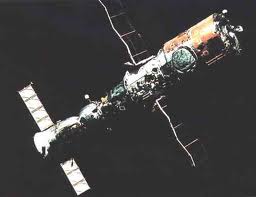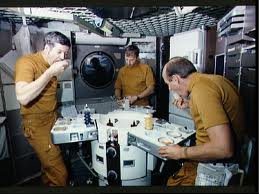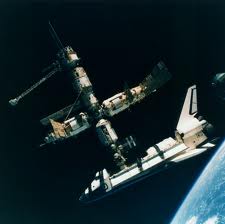In December 1972 the United States sent Apollo XVII to the Moon – the last time a human stepped on the surface of another world. Since then human activity in space has been limited to missions in near-Earth orbit. The rivalry between the Soviet Union (now Russia) and the United States continues but cooperation between the two countries has resulted in long-duration flights, space laboratories and technological innovations. By the end of the 20th century humans from in space were in the process of building a space station with the United States, Russia, Canada, Japan, Brazil and 18 countries from the European Space Agency (ESA) involved.
Humans in Space – Testing the Limits
Salyut and Almaz
The Soviet Union with the first to launch payloads big enough to allow for multiple human occupancy. This included two spacecraft, Salyut and Almaz. The name Salyut referred to the civilian Soviet program. Almaz had a military purpose.
The Soviets called Salyut and Almaz space stations but in fact they were far from the permanent orbiting platforms that were to follow in the 1980s and 1990s. Both had limited long-term habitability. Both were plagued by problems at the beginning. Neither could be refueled and both were limited by a single docking port.
The first Salyut launched in April of 1971 could not be accessed by the first human crew that attempted to board because of docking problems. The second mission with three Soyuz cosmonauts ended in tragedy on attempted reentry with the Soyuz spacecraft’s air escaping leading to the death of the crew.

The Soviets continued to launch Salyut and Almaz into near-Earth orbit finally achieving success with three deployed in succession manned by 5 separate crews. Further technological developments allowed for longer-duration Salyut flights. Modifications included two docking ports and a modified Soyuz module, called Progress, for use as a freight carrier. By 1978 Soviet crews were completing extended stays of up to 180 days. In 1978 the Soviet Salyut program invited the first foreigner onboard, Vladimir Remek , a Czechoslovak.
With increasing costs and the beginning of détente the Soviets finally abandoned the Almaz program in 1981. Salyut, however, became the core technology for the next Soviet foray into space, a true, permanent orbiting habitat, Mir.
Skylab
The Apollo Moon landings totally occupied the American program and when these flights ended, NASA sought a new initiative – to develop long-duration flight capability in low-Earth orbit. This led to Skylab, the first American-built orbiting space station built from one of the multiple stages of the Saturn rocket. Skylab weighed about 100 tons and was launched in 1973. Crews rotated every 3 months conducting solar astronomy observations, life sciences experiments, astrophysics and prolonged human exposure to space studies.

Surplus Apollo command modules shuttled the crews to and from the space station. The Skylab interior included an upper and lower floor, two airlocks, a dining area, 3 bedrooms, a common work area, shower and bathroom. Like the Salyut spacecraft Skylab was not designed as a permanent orbiting platform. Its orbit, initially at approximately 435 kilometers (270 miles) degraded and in 1979 the space station disintegrated on re-entering the atmosphere.
Mir
In 1986 the Soviets began the building of a long-duration space station called Mir, meaning “peace” and “community,” in the Russian language. Using modified Salyut and Almaz technology, Mir was modularly assembled over nine years. When completed it weighed more than 100 tons and measured 33 meters (107 feet) by 27.5 meters (90 feet) including docked Progress and Soyuz spacecraft.
Although Mir began as a Soviet project, with the collapse of the Soviet Union, it became a Russian program and soon involved international contributors and visitors from the United States, European Space Agency, Canada, Japan, Afghanistan, Bulgaria and Syria. In 1995, the first American Space Shuttle docked with Mir (see the picture below).

Mir, originally designed for a 5-year mission, hosted over 100 humans during its 15 years in orbit. Soviet and Russian cosmonauts set space endurance records with Valery Polyakov accumulating 679 days in two flights. Mir hosted the first space tourist, Dennis Tito, a multimillionaire who paid to visit the station in April 2001.
With the Russian post-Soviet economy struggling, NASA funds continued to support Mir but the two nations focused on collaborating on development of the International Space Station. Russia finally decided to decommission Mir and it re-entered and burned up in the Earth’s atmosphere in March 2001.
International Space Station
In 1998 with Mir still in orbit work began on assembling the first modules for the International Space Station. First conceived as the American answer to Mir, the first module of the station was launched into orbit by Russia, quickly followed by an American module. The work had begun on a 13-year collaborative project.
The end of the 20th century marked the end of the “Space Race” and established the beginning of a cooperative effort to develop technology for human exploration in near-Earth space.
In our next two blogs we will look at the evolution of winged spacecraft, the American Space Shuttle and the Soviet Union’s Buran program. And then we will look at space station technology after Mir including a more detailed discussion on the International Space Station and its contribution to the development of long-term human habitation in space.















